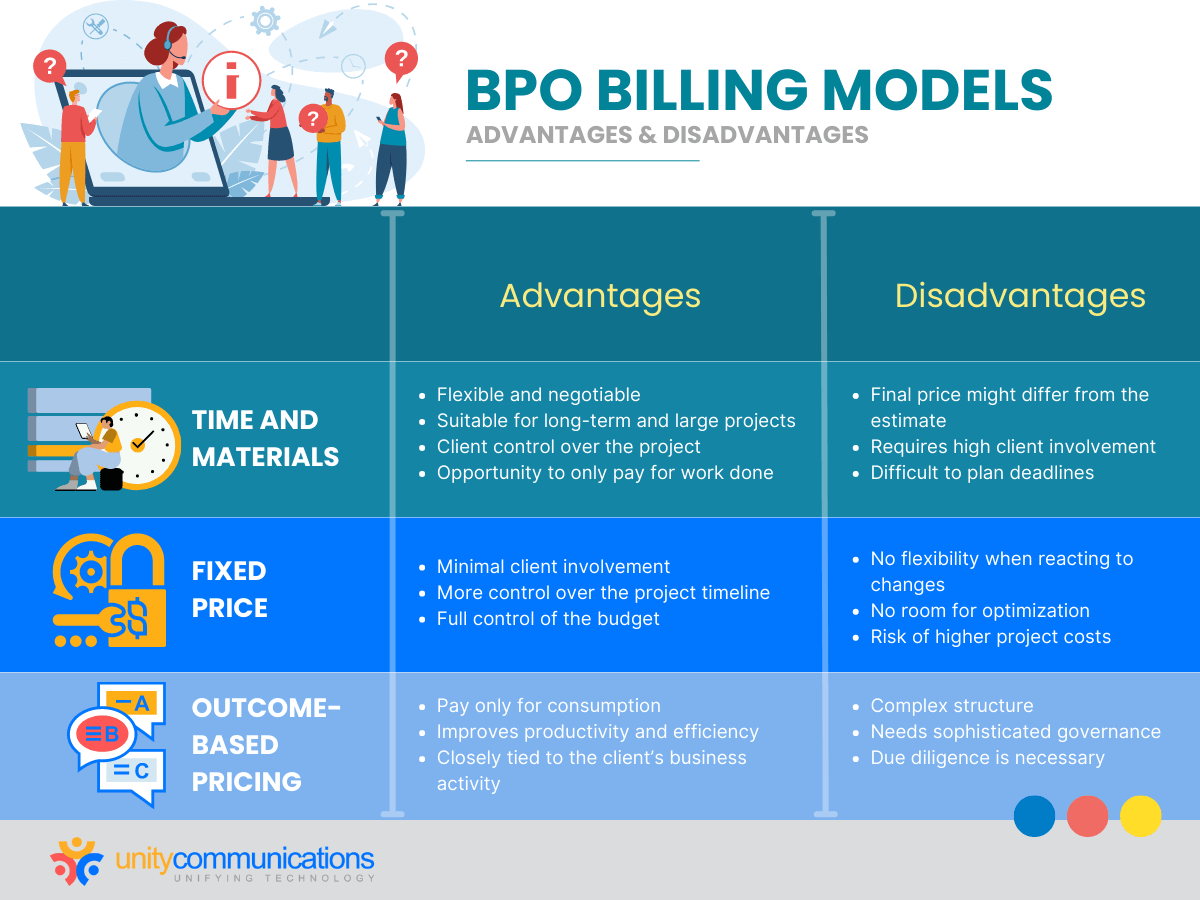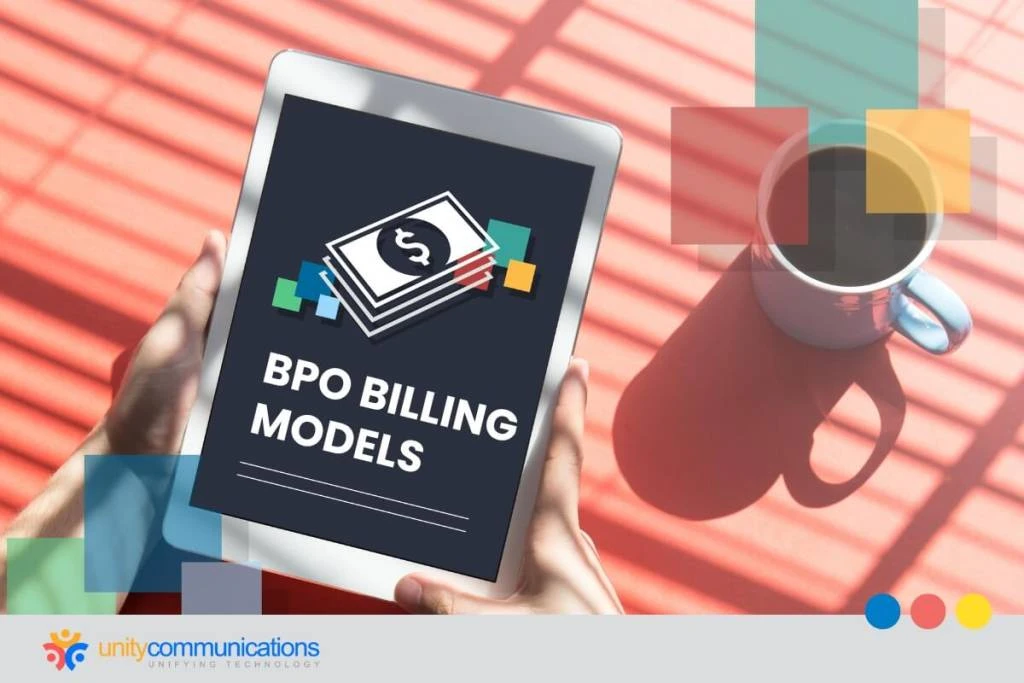Table of Contents
The benefits of business process outsourcing (BPO) include improved customer service, enhanced competitiveness, or time or cost savings that add value to your organization. After learning the benefits of the strategy, the next step is identifying BPO deals and billing schemes that work best for your organization.
This article outlines three of the most common BPO billing models service providers use, identifies their benefits and drawbacks, and assesses where each approach applies.
Read on to learn more.
BPO Billing Models and Their Pros and Cons

Let’s begin by answering the question: what is BPO? BPO entails entrusting one or more operational facets to a third-party service provider. Following clearly defined performance metrics, this provider takes on responsibility for supervising and managing the designated function. Notably, the outsourcing industry is on an upward trajectory, projected to grow at a rate of 9.4% from 2022 to 2030.
Planning is the most crucial part of outsourcing. Specifically, planning the type of BPO service and billing model you acquire can be a make-or-break decision. You benefit from various approaches depending on your industry, size, and the types of projects in your queue.
Each billing process has advantages and disadvantages. The best BPO pricing model for your business should give you flexibility and room to evolve.
Here are three of the most commonly used models:
Time and Materials
The time-and-materials model comes into play when the final product and its specific implementation details lack precision or when breaking the project into smaller stages is not feasible.
The final cost varies under this model depending on how long the vendor takes to complete the project. The BPO client is billed based on the time invested and the materials utilized during the course of the engagement, with time being compensated in hours and item expenses accounted for.
This billing approach remains open to negotiation and can adopt hourly, daily, weekly, or monthly rates for the included services. To mitigate the risk of uncontrolled cost escalation, clients can further delineate the pricing structure, specifying whether the rate hinges on the professionals’ skill sets or if a uniform rate applies across all allocated resources.
It’s worth noting that clients opting for this model shoulder greater responsibilities. This billing approach is most suitable when:
- Clear requirements or well-defined specifications are absent.
- The prediction of a continuous workflow is challenging.
- The project’s scope and implementation are uncertain.
- Clients require a high degree of flexibility.
| Advantages | Disadvantages |
|---|---|
|
|
Fixed Price
The fixed-price approach or lump-sum model is ideal for projects with a clear scope, stable requirements, and established project management methodologies.
For this model, it is ideal that both parties grasp the project requirements and have a good working relationship. The management service provider establishes a standard rate for their service offerings. Depending on the BPO client’s preference, it can be billed monthly or yearly.
With this BPO billing approach, the vendor must provide extensive details on the support service they have provided. Choose this BPO billing model when you:
- Want to outsource simple projects,
- Have clear project guidelines,
- Must stick with a given timeline,
- Expect project turnaround to be short, and
- Have a limited budget.
| Advantages | Disadvantages |
|---|---|
|
|
Outcome-based Pricing
The outcome-based model is a relatively new BPO pricing scheme. This non-conventional approach combines the vendor’s fees with defined milestones and metrics unique to the client. The metrics can involve customer satisfaction, revenue growth, or cost savings.
Of the three models, outcome-based is the hardest to manage. The client must have years of experience working with the vendor and end-to-end control of the outsourced process. Using this BPO billing model is best when:
- Outcomes are directly linked to business goals,
- A high level of innovation is necessary,
- Clients can heavily measure the outcome, and
- Results are clearly defined and measurable.
| Advantages | Disadvantages |
|---|---|
|
|
Factors to Consider When Choosing the Right BPO Billing Model

Cost control has become a priority as organizations have felt a crunch in the past few years—from vanishing profits to the inability to scale to meet sudden needs. Businesses must pick the right BPO billing model to guarantee cost control.
Consider the following factors for each approach:
- Characteristics
- Risks
- Potential challenges
- Total price
- Potential challenges for the vendor and the client
Here is a comparison of each pricing model:
| Pricing Model | Fixed Cost | Time and Materials | Outcome-based |
|---|---|---|---|
| Characteristics |
|
|
|
| Price |
|
|
|
| Risks involved |
|
|
|
| Potential challenges for the client |
|
|
|
| Potential challenges for the vendor |
|
|
|
Consider looking at examples of companies that outsource using your preferred BPO billing approach and checking their experience.
The Bottom Line
An effective BPO billing model is key to continued long-term success in outsourcing engagement. One can trace the success or failure of outsourcing, partly due to due diligence or the lack of it, to the pricing approach and underlying cost stated in the contract. So, weigh risks and drawbacks before making any major decisions.
A well-chosen billing structure facilitates the necessary governance mechanism that fairly distributes risk, effectively manages expectations, and fully satisfies the client’s needs. A misinformed pricing scheme leads to inefficiency, unpredictable expenses, mismatched incentives, and mutual mistrust.
Are you considering outsourcing? Let’s connect to discuss the applicability of each pricing model above.



